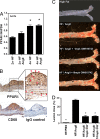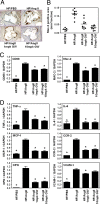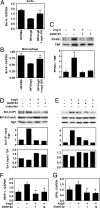PPARdelta-mediated antiinflammatory mechanisms inhibit angiotensin II-accelerated atherosclerosis
- PMID: 18337495
- PMCID: PMC2393800
- DOI: 10.1073/pnas.0708647105
PPARdelta-mediated antiinflammatory mechanisms inhibit angiotensin II-accelerated atherosclerosis
Abstract
Activation of the nuclear hormone receptor peroxisome proliferator-activated receptor delta (PPARdelta) has been shown to improve insulin resistance, adiposity, and plasma HDL levels. However, its antiatherogenic role remains controversial. Here we report atheroprotective effects of PPARdelta activation in a model of angiotensin II (AngII)-accelerated atherosclerosis, characterized by increased vascular inflammation related to repression of an antiinflammatory corepressor, B cell lymphoma-6 (Bcl-6), and the regulators of G protein-coupled signaling (RGS) proteins RGS4 and RGS5. In this model, administration of the PPARdelta agonist GW0742 (1 or 10 mg/kg) substantially attenuated AngII-accelerated atherosclerosis without altering blood pressure and increased vascular expression of Bcl-6, RGS4, and RGS5, which was associated with suppression of inflammatory and atherogenic gene expression in the artery. In vitro studies demonstrated similar changes in AngII-treated macrophages: PPARdelta activation increased both total and free Bcl-6 levels and inhibited AngII activation of MAP kinases, p38, and ERK1/2. These studies uncover crucial proinflammatory mechanisms of AngII and highlight actions of PPARdelta activation to inhibit AngII signaling, which is atheroprotective.
Conflict of interest statement
The authors declare no conflict of interest.
Figures





Similar articles
-
Peroxisome proliferator-activated receptor δ agonist GW1516 attenuates diet-induced aortic inflammation, insulin resistance, and atherosclerosis in low-density lipoprotein receptor knockout mice.Arterioscler Thromb Vasc Biol. 2014 Jan;34(1):52-60. doi: 10.1161/ATVBAHA.113.301830. Epub 2013 Oct 24. Arterioscler Thromb Vasc Biol. 2014. PMID: 24158519
-
Activation of peroxisome proliferator-activated receptor delta inhibits streptozotocin-induced diabetic nephropathy through anti-inflammatory mechanisms in mice.Diabetes. 2011 Mar;60(3):960-8. doi: 10.2337/db10-1361. Epub 2011 Jan 26. Diabetes. 2011. PMID: 21270242 Free PMC article.
-
The Sirt1 activator SRT1720 attenuates angiotensin II-induced atherosclerosis in apoE⁻/⁻ mice through inhibiting vascular inflammatory response.Biochem Biophys Res Commun. 2015 Oct 2;465(4):732-8. doi: 10.1016/j.bbrc.2015.08.066. Epub 2015 Aug 18. Biochem Biophys Res Commun. 2015. PMID: 26296466
-
PPARdelta regulates multiple proinflammatory pathways to suppress atherosclerosis.Proc Natl Acad Sci U S A. 2008 Mar 18;105(11):4271-6. doi: 10.1073/pnas.0711875105. Epub 2008 Mar 12. Proc Natl Acad Sci U S A. 2008. PMID: 18337509 Free PMC article.
-
Peroxisome proliferator-activated receptor δ: a multifaceted metabolic player.Curr Opin Lipidol. 2013 Apr;24(2):171-7. doi: 10.1097/MOL.0b013e32835cc949. Curr Opin Lipidol. 2013. PMID: 23481229 Review.
Cited by
-
Elevated Adiponectin Levels Suppress Perivascular and Aortic Inflammation and Prevent AngII-induced Advanced Abdominal Aortic Aneurysms.Sci Rep. 2016 Sep 23;6:31414. doi: 10.1038/srep31414. Sci Rep. 2016. PMID: 27659201 Free PMC article.
-
PPARs in the Renal Regulation of Systemic Blood Pressure.PPAR Res. 2010;2010:698730. doi: 10.1155/2010/698730. Epub 2010 Jun 8. PPAR Res. 2010. PMID: 20613959 Free PMC article.
-
Peroxisome proliferator activating receptor (PPAR) in cerebral malaria (CM): a novel target for an additional therapy.Eur J Clin Microbiol Infect Dis. 2011 Apr;30(4):483-98. doi: 10.1007/s10096-010-1122-9. Epub 2010 Dec 9. Eur J Clin Microbiol Infect Dis. 2011. PMID: 21140187 Review.
-
GW501516, a PPARδ agonist, ameliorates tubulointerstitial inflammation in proteinuric kidney disease via inhibition of TAK1-NFκB pathway in mice.PLoS One. 2011;6(9):e25271. doi: 10.1371/journal.pone.0025271. Epub 2011 Sep 22. PLoS One. 2011. PMID: 21966476 Free PMC article.
-
Transcriptional Factors Mediating Retinoic Acid Signals in the Control of Energy Metabolism.Int J Mol Sci. 2015 Jun 23;16(6):14210-44. doi: 10.3390/ijms160614210. Int J Mol Sci. 2015. PMID: 26110391 Free PMC article. Review.
References
-
- Halkin A, Keren G. Potential indications for angiotensin-converting enzyme inhibitors in atherosclerotic vascular disease. Am J Med. 2002;112:126–134. - PubMed
-
- Weiss D, Kools JJ, Taylor WR. Angiotensin II-induced hypertension accelerates the development of atherosclerosis in apoE-deficient mice. Circulation. 2001;103:448–454. - PubMed
-
- Dol F, et al. Angiotensin AT1 receptor antagonist irbesartan decreases lesion size, chemokine expression, and macrophage accumulation in apolipoprotein E-deficient mice. J Cardiovasc Pharmacol. 2001;38:395–405. - PubMed
-
- Dandona P, Dhindsa S, Ghanim H, Chaudhuri A. Angiotensin II and inflammation: The effect of angiotensin-converting enzyme inhibition and angiotensin II receptor blockade. J Hum Hypertens. 2007;21:20–27. - PubMed
Publication types
MeSH terms
Substances
Grants and funding
LinkOut - more resources
Full Text Sources
Medical
Molecular Biology Databases
Miscellaneous

